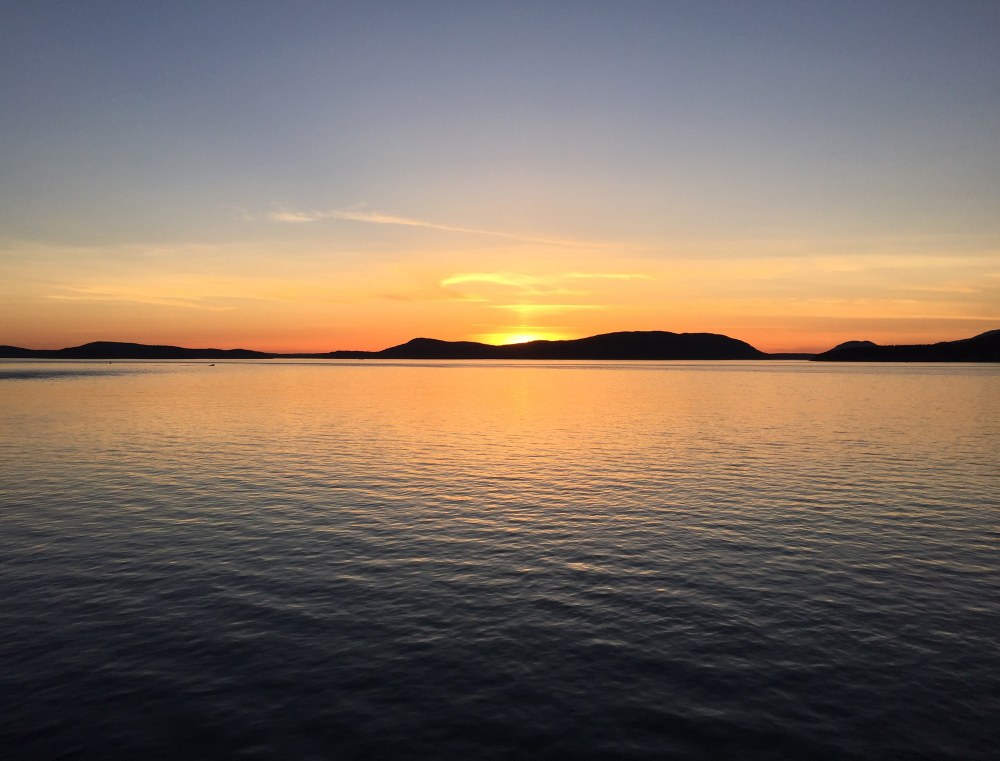
Western Washington is spectacular in the summer. After eight months of wet, overcast weather, July brings sunshine and boosts morale just when we need it most. But between seasonal residents and tourists, and the desire to squeeze a year’s worth of adventures into three dry months, our state gets busy. Lines of cars wind up Mount Rainier, campsites are booked for months, and good luck getting Enchantments permits. Worst of all is the dreaded ferry line. Ferries themselves can be enjoyable, but if you don't have the foresight to book your ferry reservation in advance, you may find yourself waiting all day in a hot parking lot for the next open spot.
What if I told you there was a better way? What if I said you could access one of Washington’s most popular destinations—and all the camping, wine, pastries, and seafood it has to offer—without the headache of traffic and ferry reservations? All you need to start is a bicycle.
Getting started bike touring
Beginning as a bike tourist can be intimidating. I found the simplest way to get started is to use a modified version of my backpacking setup. The core components of the gear are the same for a comfortable night camping, but include a few specifics to keep you safe and rolling along.
Suggested gear:
- Panniers or bike bags (you need a way to carry your gear) and corresponding rear and/or front bike bag racks
- Tent
- Sleeping bag and pad
- Camp stove and pots
- Lighter or matches
- Water bottles
- Tire patch kit with spare tubes and a pump
- Multi-tool
- Weather appropriate layers (rain jacket and pants, puffy jacket, long underwear)
- Headlamp
- Front and/or rear bike lights
Whether you’re a seasoned bike tourist or looking to dip your wheels into a new type of adventure, touring the San Juan Islands has something for everyone. I’ve taken this trip annually for the last six or seven years, and I regularly make tweaks to encompass more of the things I enjoy and less of the things I don’t. Feel free to modify the packing list or itinerary for your adventure. This is your opportunity to reconnect—or connect for the first time—with the freedom of cycling as you explore a place from a new perspective.
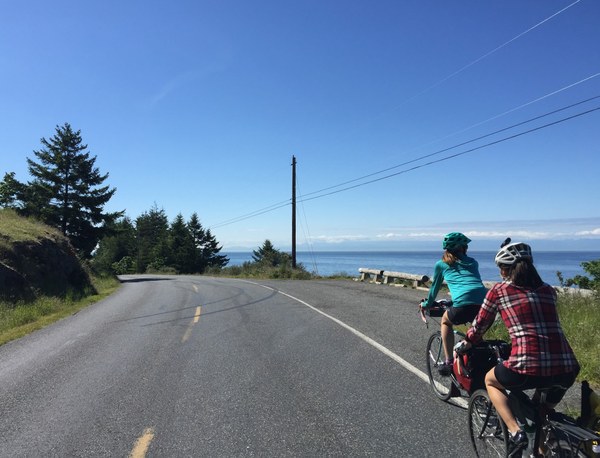 Cyclists appreciating the smooth rides and sweeping views of San Juan Island.
Cyclists appreciating the smooth rides and sweeping views of San Juan Island.
Day 1
Friday afternoon, 10 miles, San Juan Island (part one)
To get the most out of the weekend, I prefer to head to Anacortes early on Friday by car. Anacortes lies roughly an hour and a half north of Seattle, though it can take much longer to get there with weekend traffic. Once you arrive at the Anacortes ferry terminal, you have several parking options near the ferry entrance. Parking at the official ferry terminal can cost $10-20 per day, but the offsite parking outside the ferry terminal is significantly cheaper.
Once you ditch the car, the fun begins. The quick ride to the ferry doesn’t even require peddling. Coast down the hill and past the cars to the ticketing office, throwing a few smug waves along the way as you skip the line. Grab your round-trip ticket to Friday Harbor on San Juan Island and wait for the next boat to depart. All walk- and bike-on ferry tickets from Anacortes are round-trip, and your ticket includes inter-island ferry travel as well as the trip back. Ferry schedules can be found on the WSDOT website and typically run every couple hours and into the night.
 A Lopez Island map greets cyclists at Odlin Park, shortly after leaving the ferry.
A Lopez Island map greets cyclists at Odlin Park, shortly after leaving the ferry.
While on the ferry, relax and enjoy the ride. Grab a drink from the galley or head to the sun deck for breathtaking views of the islands. If you’re lucky, you may catch a glimpse of marine life playing on the water’s surface.
You’ll land in Friday Harbor, the primary commercial center of San Juan Island. If you’re hungry, you have several options to eat in close riding distance. Golden Triangle provides reliable Thai favorites for a quick dinner before hopping back in the saddle. For something higher-end with waterfront views, Downrigger’s has American fare and cocktails that you can enjoy on an outdoor patio. I recommend their smoked salmon Reuben. If you’re planning a camp feast, King’s Market is a great place to stop for last-minute grocery items. Outside of Friday Harbor, very few places offer the opportunity to stock up on supplies, so be sure to get everything you need before setting out for camp.
Camping is the primary reason for making San Juan Island your first stop. San Juan County Park remains one of my all-time favorite camp sites. Perched on a bluff above Haro Strait, San Juan County Park gives unmatched views of the water and Vancouver Island. The park is a breezy ten miles from Friday Harbor, and Beaverton Valley Road takes you most of the way there as you pedal through the island’s rolling farmlands. Since you’re arriving via bike, you get prime access to the hiker and biker camp sites closest to the bluffs with the best views. Get to camp early enough to secure the best spot and catch a sunset over Vancouver Island.
Day 2
Saturday, 41 miles, San Juan Island (part two)
After a night sleeping by the sea, you’re well rested and ready for today’s adventure: circumnavigating the island. I recommend traveling counterclockwise, heading south out of the campground.
Your first stop lies a couple miles south of San Juan County Park, Lime Kiln Point State Park. This is a great spot for a cup of Joe and is said to be among the best spots in the world for orca sightings. The park lighthouse is a center for orca research and provides a list of recent sightings along with information on local wildlife.
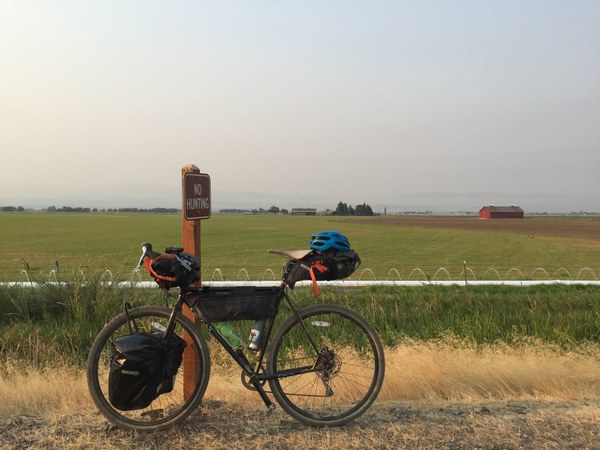 Just one of countless touring set-ups a rider can adopt to make their own.
Just one of countless touring set-ups a rider can adopt to make their own.
When you’re finished sipping coffee and searching for orcas, continue south on West Side Road to Bailer Hill Road before heading left down Douglas Road. Here you have two options: continue straight to Friday Harbor, or add some miles (and hills) by detouring through San Juan Island National Historical Park to the Cattle Point Lighthouse, another great place for sightseeing and stretching your legs among the seaside trails.
If you’re looking for a snack, the Friday Harbor Farmers Market runs 9:30am-1pm every Saturday from April through October. Cynthia’s has you covered with sweet and savory offerings, and for something more substantial you can’t go wrong with Tibetan dumplings at Ultimate Momos. Grab some food, kick back on the lawn, and listen to live music before you go back for seconds, or even thirds. Vendors tend to change each week so if you have your appetite set on something specific, check the San Juan Island Farmers Market website.
Now that your belly is full and you’re ready to hop back on the bike, consider trying some of the island’s finest vino to wash down the last of your lunch. Just four miles north of the farmers market lies San Juan Vineyard, the only operating winery on the island. Stop in and get some tasters or a bottle to sip and share with friends on the patio.
When you’re ready to continue on, keep north on Roche Harbor Road for another six miles until you reach Afterglow Drive. Turn right and you’ll find yourself at the parking lot for Afterglow Vista. Completed in 1936, Afterglow Vista is a mausoleum and final resting place for John McMillin—a wealthy businessman—and his family who resided on San Juan Island in the early 1900s. Stash your bikes at the parking lot and hike a couple hundred yards down the trail where you’ll be greeted by a stone archway and columns surrounding a concrete table and several chairs. Each concrete chair houses the cremated remains of a member of the McMillin family. Legend has it if you visit after dark you may witness blue light orbs floating in the chairs, said to be the return of family members visiting from the beyond.
On your way back to camp, you have the option to stop at a few places. Down the road from Afterglow lies Roche Harbor, a swanky seaside resort with high-end dining options and lots of yachts. If that’s not your thing, check out the sculpture garden located just before the resort. If you’re running low on daylight and eager to get back to camp, follow Roche Harbor Road back the way you came until you get to West Valley Road. This takes you past English Camp, a British army camp established in 1859 when San Juan Island was a shared territory between Great Britain and the United States. Beyond English Camp, you’ll take a right on Mitchell Bay Road which eventually turns to West Valley Road and puts you right back into your campground.
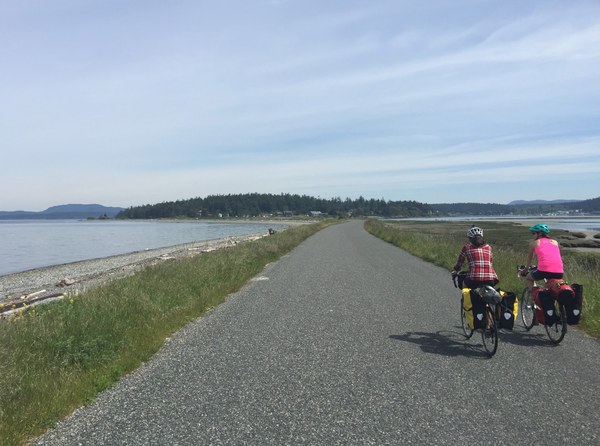 Cyclists on Bayshore Road enjoying 360-degree water views as they approach Fisherman Bay.
Cyclists on Bayshore Road enjoying 360-degree water views as they approach Fisherman Bay.
Day 3
Sunday, 33 miles, Lopez Island
With a significantly lower population and fewer tourist attractions, Lopez Island is arguably the best island for biking and why I like to save it for my last day of the weekend. Cyclists also laud Lopez Island for its biking since it’s fairly flat relative to the other islands.
In previous years, I’ve explored Lopez Island a few different ways. Depending on how much daylight is left after biking San Juan Island on Saturday, you can pack up camp and catch the ferry Saturday afternoon or evening, allowing you to camp on Lopez that night. If you choose to do this, there are two different camping options, both fairly close to the Lopez Island ferry terminal. Odlin County Park is my first suggestion because it’s just a mile from the ferry and easy to find a campsite. To get there, take a right on Odlin Park Road just as you get over the hill from the ferry. Camping at Odlin Park is the one and only time I have seen the Northern lights. Though I suspect it’s rare, keep your fingers crossed that you get the same light show.
The other camp is Spencer Spit State Park, but it’s a harder site to land because it’s more popular and has views of Mount Baker. Instead of taking a right on Odlin Park Road, take a left on Port Stanley and follow this road to Bakerview Road which takes you directly to the park, just over four miles from the ferry.
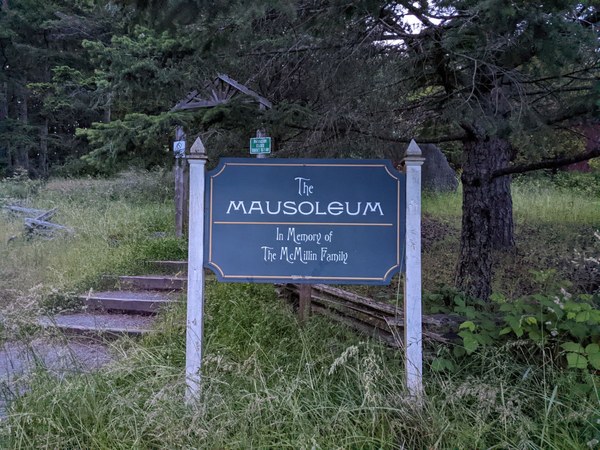 A sign for "The Mausoleum" reminding visitors that Afterglow Vista is a memorial for the McMillin Family.
A sign for "The Mausoleum" reminding visitors that Afterglow Vista is a memorial for the McMillin Family.
Regardless of the site you choose, camping overnight on Lopez will allow you a leisurely morning and more time to explore the island on Sunday. While I generally opt for the hiker and biker sites, all camp sites are reservable with enough planning, and Washington State PRO 65-8 guarantees bike riders a place to stay at state campgrounds even if the camp is completely full. This ensures that you won’t be turned away on a busy weekend.
If you’re planning to stay another night on San Juan Island, I suggest an early rise to catch a morning ferry to Lopez Island, as it’s a ten mile ride from camp to the ferry in Friday Harbor. Once on Lopez, book it to Holly B’s bakery, one of the island’s most popular breakfast spots. Try one of the cinnamon rolls or a veggie strata. You can thank me later.
Post-cinnamon roll, make your way down Fisherman’s Bay Road. As you work your way south, you’ll roll through farmland along two-lane roads that you often have all to yourself. If you have time, keep your eye out for Shark Reef Sanctuary and Agate Beach County Park. Both offer short hikes and water access with incredible views of the Strait of Juan de Fuca.
My favorite thing about Lopez Island is that you can make it exactly what you want it to be. Take time to explore side roads, find a hidden sandy beach and stop for a snack, or enjoy the rolling hills as you make your way across the island. When you decide to call it a day, head back up to the ferry terminal to catch the next ride back to Anacortes. Better yet, call in sick Monday and jump over to Orcas Island to keep your weekend-on-wheels rolling.
This article originally appeared in our spring 2023 issue of Mountaineer magazine. To view the original article in magazine form and read more stories from our publication, visit our magazine archive.
 Sam Hendrix
Sam Hendrix